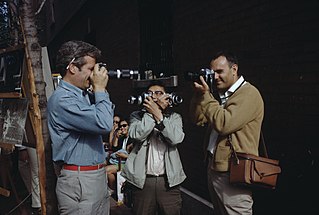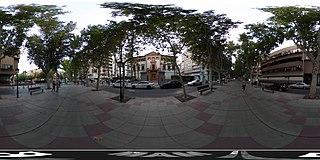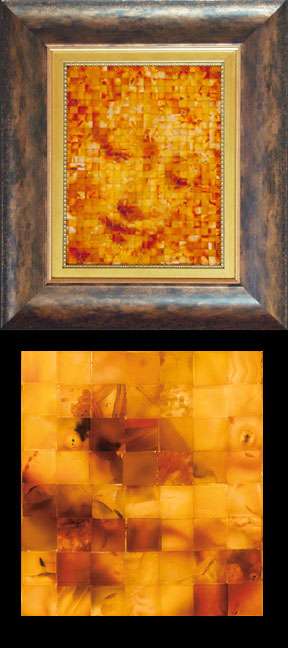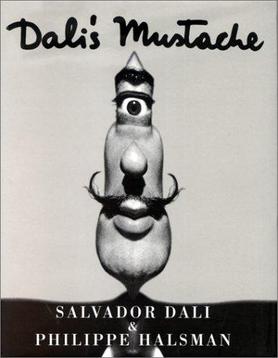
Photography is the art, application, and practice of creating images by recording light, either electronically by means of an image sensor, or chemically by means of a light-sensitive material such as photographic film. It is employed in many fields of science, manufacturing, and business, as well as its more direct uses for art, film and video production, recreational purposes, hobby, and mass communication.

In digital imaging, a pixel, pel, or picture element is the smallest addressable element in a raster image, or the smallest addressable element in a dot matrix display device. In most digital display devices, pixels are the smallest element that can be manipulated through software.

Digital art refers to any artistic work or practice that uses digital technology as part of the creative or presentation process. It can also refer to computational art that uses and engages with digital media.

A tintype, also known as a melanotype or ferrotype, is a photograph made by creating a direct positive on a thin sheet of metal, colloquially called 'tin', coated with a dark lacquer or enamel and used as the support for the photographic emulsion. It was introduced in 1853 by Adolphe Alexandre Martin in Paris, like the daguerreotype was fourteen years before by Daguerre. The daguerreotype was established and most popular by now, though the primary competition for the tintype would have been the ambrotype, that shared the same collodion process, but on a glass support instead of metal. Both found unequivocal, if not exclusive, acceptance in North America. Tintypes enjoyed their widest use during the 1860s and 1870s, but lesser use of the medium persisted into 1930s and it has been revived as a novelty and fine art form in the 21st century. It has been described as the first "truly democratic" medium for mass portraiture.

Compositing is the process or technique of combining visual elements from separate sources into single images, often to create the illusion that all those elements are parts of the same scene. Live-action shooting for compositing is variously called "chroma key", "blue screen", "green screen" and other names. Today, most, though not all, compositing is achieved through digital image manipulation. Pre-digital compositing techniques, however, go back as far as the trick films of Georges Méliès in the late 19th century, and some are still in use.

The history of photography began with the discovery of two critical principles: The first is camera obscura image projection, the second is the discovery that some substances are visibly altered by exposure to light. There are no artifacts or descriptions that indicate any attempt to capture images with light sensitive materials prior to the 18th century.

Image stitching or photo stitching is the process of combining multiple photographic images with overlapping fields of view to produce a segmented panorama or high-resolution image. Commonly performed through the use of computer software, most approaches to image stitching require nearly exact overlaps between images and identical exposures to produce seamless results, although some stitching algorithms actually benefit from differently exposed images by doing high-dynamic-range imaging in regions of overlap. Some digital cameras can stitch their photos internally.

Charactron was a U.S. registered trademark of Consolidated Vultee Aircraft Corporation (Convair) for its shaped electron beam cathode ray tube. Charactron CRTs performed functions of both a display device and a read-only memory storing multiple characters and fonts. The similar Typotron was a U.S. registered trademark of Hughes Aircraft Corporation for its type of shaped electron beam storage tube with a direct-view bistable storage screen.

Digital photography uses cameras containing arrays of electronic photodetectors interfaced to an analog-to-digital converter (ADC) to produce images focused by a lens, as opposed to an exposure on photographic film. The digitized image is stored as a computer file ready for further digital processing, viewing, electronic publishing, or digital printing. It is a form of digital imaging based on gathering visible light.
Leon D. Harmon was a researcher in mental/neural processing, particularly regarding vision, who worked at Bell Telephone Laboratories, Incorporated.

Kenneth Charles Knowlton was an American computer graphics pioneer, artist, mosaicist and portraitist. In 1963, while working at Bell Labs, he developed the BEFLIX programming language for creating bitmap computer-produced movies. In 1966, also at Bell Labs, he and Leon Harmon created the computer artwork Computer Nude .
A chromogenic print, also known as a C-print or C-type print, a silver halide print, or a dye coupler print, is a photographic print made from a color negative, transparency or digital image, and developed using a chromogenic process. They are composed of three layers of gelatin, each containing an emulsion of silver halide, which is used as a light-sensitive material, and a different dye coupler of subtractive color which together, when developed, form a full-color image.

VR photography is the interactive viewing of panoramic photographs, generally encompassing a 360-degree circle or a spherical view. The results is known as VR photograph, 360-degree photo, photo sphere, or spherical photo, as well as interactive panorama or immersive panorama.

Unlike traditional mosaics which rely on differently colored material arranged in arbitrary configurations to make an image, impressionist mosaics are created using the natural flaws and marbling in the tiles to create the impression of an image. Depending on the definition, this may be limited to arranging square, homogeneously colored tiles in a grid-like, non-overlapped fashion.

Image editing encompasses the processes of altering images, whether they are digital photographs, traditional photo-chemical photographs, or illustrations. Traditional analog image editing is known as photo retouching, using tools such as an airbrush to modify photographs or editing illustrations with any traditional art medium. Graphic software programs, which can be broadly grouped into vector graphics editors, raster graphics editors, and 3D modelers, are the primary tools with which a user may manipulate, enhance, and transform images. Many image editing programs are also used to render or create computer art from scratch. The term "image editing" usually refers only to the editing of 2D images, not 3D ones.

Lincoln in Dalivision is a 1977 original limited edition lithograph created by Salvador Dalí. It is often considered one of the most counterfeited Dalí lithographs. Dalí authentication experts who have noted the counterfeiting issue with this work include Albert Field, Frank Hunter, Robert Descharnes and Bernard Ewell. Lee Catterall comments in his book The Great Dalí Art Fraud & other deceptions, "The painting most commonly reproduced for such fraudulent purposes was Lincoln in Dalivision, 'prints' of which Los Angeles art appraiser Dena Hall testified in the Hawaii trial have become as commonplace as 'pancakes at the pancake house.'"

Pixel Camera, formerly Google Camera, is a camera phone application developed by Google for the Android operating system. Development for the application began in 2011 at the Google X research incubator led by Marc Levoy, which was developing image fusion technology for Google Glass. It was publicly released for Android 4.4+ on the Google Play on April 16, 2014. It was initially supported on all devices running Android 4.4 KitKat and higher, but became only officially supported on Google Pixel devices in the following years. The app was renamed Pixel Camera in October 2023, with the launch of the Pixel 8 and Pixel 8 Pro.

Dali's Mustache is an absurdist humorous book by the surrealist artist Salvador Dalí (1904–1989) and his friend, the photographer Philippe Halsman (1906–1979). The first edition was published in October 1954 in New York; slightly modified French editions followed in the 1980s and 1990s.


















